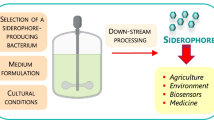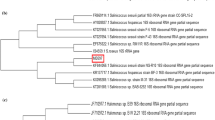Abstract
In the present study, siderophore produced by the marine yeast Aureobasidium pullulans was characterized as hydroxamate by chemical and bioassays. The hydroxamate assignment was supported by the appearance of peaks at 1,647.21–1,625.99 cm−1 and at 1,435.04 cm−1 in the infrared spectrum. The purified siderophore exhibited specific growth-promoting activity under iron-limited conditions for siderophore auxotrophic probiotic bacteria. Cross-utilization of siderophore indicates a symbiotic relationship between the yeast A. pullulans and the selected probiotic bacterial strains. Statistical optimization of medium components for improved siderophore production in A. pullulans was depicted by response surface methodology. The shift in UV–Vis spectroscopy indicates the photoreactive property and subsequent oxidative cleavage of purified siderophore on exposure to sunlight.







Similar content being viewed by others
References
Dhungana, S., Harrington, J. M., Gebhardt, P., Möllmann, U., & Crumbliss, A. L. (2007). Iron chelation equilibria, redox, and siderophore activity of a saccharide platform ferrichrome analogue. Inorganic Chemistry, 46, 8362–8371.
Quatrini, R., Jedlicki, E., & Holmes, D. S. (2005). Genomic insights into the iron uptake mechanisms of the biomining microorganism Acidithiobacillus ferrooxidans. Journal of Industrial Microbiology and Biotechnology, 32, 606–614.
Merkofer, M., Kissner, R., Hider, R. C., Brunk, U. T., & Koppenol, W. H. (2006). Fenton chemistry and iron chelation and physiologically relevant conditions: electrochemistry and kinetics. Chemical Research in Toxicology, 19, 1263–1269.
Winkelmann, G. (2002). Microbial siderophore-mediated transport. Biochemical Society Transactions, 30, 691–696.
Chi, Z. M., Liu, G., Zhao, S., Li, J., & Peng, Y. (2010). Marine yeasts as biocontrol agents and producers of bioproducts. Applied Microbiology and Biotechnology, 86, 1227–1241.
Li, J. F., & Chi, Z. M. (2004). Siderophores from marine microorganisms and their applications. Journal of Ocean University of China, 3, 40–47.
de Hoog, G. S. (1993). Evolution of black yeasts: possible adaption to the human host. Antonie Van Leeuwenhoek, 63, 105–109.
Chi, Z. M., Wang, F., Chi, Z., Yue, L., Liu, G., & Zhang, T. (2009). Bioproducts from Aureobasidium pullulans, a biotechnologically important yeast. Applied Microbiology and Biotechnology, 82, 793–804.
Liu, J., Liu, Z., Chi, Z. M., Zhang, L., & Zhang, D. (2009). Intraspecific diversity of Aureobasidium pullulans strains from different marine environments. Journal of Ocean University of China, 8, 241–246.
Johnson, L. (2008). Iron and siderophores in fungal–host interactions. Mycological Research, 112, 170–183.
Ratledge, C., & Dover, L. G. (2000). Iron metabolism in pathogenic bacteria. Annual Review of Microbiology, 54, 881–941.
Hartmann, A., & Braun, V. (1980). Iron transport in Escherichia coli: uptake and modification of ferrichrome. Journal of Bacteriology, 143, 246–255.
West, S. A., & Buckling, A. (2003). Cooperation, virulence and siderophore production in bacterial parasites. Proceedings of the Royal Society of London, 270, 37–44.
Noordman, W. H., Reissbrodt, R., Bongers, R. S., Rademaker, J. L. W., Bockelmann, W., & Smit, G. (2006). Growth stimulation of Brevibacterium sp. by siderophores. Journal of Applied Microbiology, 101, 637–646.
Amin, S. A., Green, D. H., Mark, H. C., Kupper, F. C., Sunda, W. G., & Carrano, C. J. (2009). Photolysis of iron–siderophore chelates promotes bacterial–algal mutualism. Proceedings of the National Academy of Sciences, 106, 17071–17076.
Yarrow, D. (1998). Methods for the isolation, maintenance, classification and identification of yeasts. In C. P. Kurtzman & J. W. Fell (Eds.), The yeasts: a taxonomic study (4th ed., pp. 77–100). Amsterdam: Elsevier Science BV.
Wang, L., Yue, L. X., Chi, Z. M., & Wang, X. H. (2008). Marine killer yeasts active against the pathogenic yeast strain in crab (Portunus trituberculatus). Disease and Aquatic Organisms, 80, 211–218.
Thanh, V. N., Van Dyk, M. S., & WingWeld, M. J. (2002). Debaryomyces mycophilus sp. nov., a siderophore-dependent yeast isolated from woodlice. FEMS Yeast Research, 2, 415–427.
Thompson, J. D., Higgins, D. G., & Gibson, T. J. (1994). CLUSTAL W: improving the sensitivity of progressive multiple sequence alignment through sequence weighting, position-specific gap penalties and weight matrix choice. Nucleic Acids Research, 22, 4673–4680.
Hall, T. A. (1999). BioEdit: a user-friendly biological sequence alignment editor and analysis program for windows 95/98/NT. Nucleic Acids Symposium Series, 41, 95–98.
Wang, W. L., Chi, Z. M., Chi, Z., Li, J., & Wang, X. H. (2009). Siderophore production by the marine-derived Aureobasidium pullulans and its antimicrobial activity. Bioresource Technology, 100, 2639–2641.
Payne, S. M. (1994). Detection, isolation and characterization of siderophores. Methods in Enzymology, 235, 329–344.
Deneer, H. G., & Boychuk, I. (1993). Reduction of iron by Listeria monocytogenes and other species of Listeria. Canadian Journal of Microbiology, 39, 480–485.
Bas, D., & Boyaci, I. H. (2007). Modeling and optimization I: Usability of response surface methodology. Journal of Food Engineering, 78, 836–845.
Chou, K. W., Norli, I., & Anees, A. (2010). Evaluation of the effect of temperature, NaOH concentration and time on solubilization of palm oil mill effluent (POME) using response surface methodology (RSM). Bioresource Technology, 101, 8616–8622.
Sayeed, R. Z., & Chincholkar, S. B. (2006). Purification of siderophores of Alkaligenes faecalis on Amberlite XAD. Bioresource Technology, 97, 1026–1029.
Patel, A. K., Deshattiwar, M. K., Chaudhari, B. L., & Chincholkar, S. B. (2009). Production, purification and chemical characterization of the catecholate siderophore from potent probiotic strains of Bacillus spp. Bioresource Technology, 100, 368–373.
Macrellis, H. M., Trick, C. G., Rue, E. L., & Bruland, K. W. (2001). Collection and detection of natural Fe-binding ligands from seawater. Marine Chemistry, 76, 175–187.
Winkelmann, G., Schmid, D. G., Nicholson, G., Jung, G., & Colquhoun, D. J. (2002). Bisucaberin-A dihydroxamate siderophore isolated from Vibrio salmonicida, an important pathogen of farmed Atlantic salmon (Salmo salar). BioMetals, 15, 153–160.
Bradford, M. M. (1976). A rapid and sensitive method for the quantification of microgram quantities of proteins utilizing the principle of protein-dye binding. Analytical Biochemistry, 72, 248–254.
Schrettl, M., Bignell, E., Kragl, C., Joechl, C., Rogers, T., Arst, H. N., Jr., et al. (2004). Siderophore biosynthesis but not reductive iron assimilation is essential for Aspergillus fumigatus virulence. The Journal of Experimental Medicine, 200, 1213–1219.
Raymond, K. N., & Dertz, E. A. (2004). Biochemical and physical properties of siderophores. In J. H. Crosa, A. R. Mey, & S. M. Payne (Eds.), Iron transport in bacteria (pp. 3–17). Washington, DC: ASM Press.
Baakza, A., Dave, B. P., & Dube, H. C. (2004). Chemical nature, ligand denticity and quantification of fungal siderophores. Indian Journal of Experimental Biology, 42, 96–105.
Gatesoupe, F. J. (2007). Live yeasts in the gut: natural occurrence, dietary introduction, and their effects on fish health and development. Aquaculture, 267, 20–30.
Cabaj, A., & Kosakowska, A. (2009). Iron-dependent growth of and siderophore production by two heterotrophic bacteria isolated from brackish water of the southern Baltic Sea. Microbiological Research, 164, 570–577.
Murugappan, R. M., Aravinth, A., & Karthikeyan, M. (2011). Chemical and structural characterization of hydroxamate siderophore produced by marine Vibrio harveyi. Journal of Industrial Microbiology and Biotechnology, 38, 265–273.
Singh, A., Mishra, A. K., Singh, S. S., Sarma, H. K., & Shukla, E. (2008). Influence of iron and chelator on siderophore production in Frankia strains nodulating Hippophae salicifolia D. Don. Journal of Basic Microbiology, 48, 104–111.
Calvente, V., de Orellano, M. E. S., Benuzzi, D., & de Tosetti, M. I. S. (2001). Effects of nitrogen source and pH on siderophore production by Rhodotorula strains and their application to control of phytopathogenic moulds. Journal of Industrial Microbiology and Biotechnology, 26, 226–229.
Singh, A. K., Mehta, G., & Chhatpar, H. S. (2009). Optimization of medium constituents for improved chitinase production by Paenibacillus sp. D1 using statistical approach. Letters in Applied Microbiology, 49, 708–714.
Lopes, M. A., Gomes, D. S., Bello Koblitz, M. G., Pirovani, C. P., Cézar De Mattos Cascardo, J., Goes-Neto, A., et al. (2008). Use of response surface methodology to examine chitinase regulation in the basidiomycete Moniliophthora perniciosa. Mycological Research, 112, 399–406.
Jiang, L. (2010). Optimization of fermentation conditions for pullulan production by Aureobasidium pullulans using response surface methodology. Carbohydrate Polymer, 79, 414–417.
Freibach, H. S., Yariv, S., Lapides, Y., Hadar, Y., & Chen, Y. (2005). Thermo-FTIR spectroscopic study of the siderophore ferrioxamine B: spectral analysis and stereochemical implications of iron chelation, pH and temperature. Journal of Agricultural and Food Chemistry, 53, 3434–3443.
Barbeau, K., Rue, E. L., Bruland, K. W., & Butler, A. (2001). Photochemical cycling of iron in the surface ocean mediated by microbial iron(III)-binding ligands. Nature, 413, 409–413.
Martin, J. D., Ito, Y., Homann, V. V., Haygood, M. G., & Butler, A. (2006). Structure and membrane affinity of new amphiphilic siderophores produced by Ochrobactrum sp. SP18. Journal of Biological Inorganic Chemistry, 11, 633–641.
Harrison, F., Browning, L. E., Vos, M., & Buckling, A. (2006). Cooperation and virulence in acute Pseudomonas aeruginosa infections. BMC Biology, 4, 21.
Acknowledgment
The authors thank College management for providing necessary facilities. Financial assistance provided by UGC, CSIR, and MoEF is greatly acknowledged.
Author information
Authors and Affiliations
Corresponding author
Rights and permissions
About this article
Cite this article
Murugappan, R., Karthikeyan, M., Aravinth, A. et al. Siderophore-Mediated Iron Uptake Promotes Yeast–Bacterial Symbiosis. Appl Biochem Biotechnol 168, 2170–2183 (2012). https://doi.org/10.1007/s12010-012-9926-y
Received:
Accepted:
Published:
Issue Date:
DOI: https://doi.org/10.1007/s12010-012-9926-y




